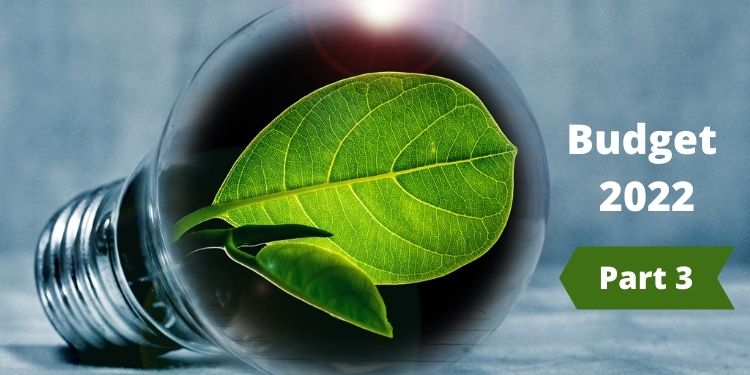The past two years have been very difficult for all in general. The new normal in a world where Covid-19, unfortunately, has become part of our life and will bring about many changes in the way businesses will be conducted, and more importantly the way we live our life. The Union Budget 2022 -23 is being keenly watched by many sectors. The 3rd& 4th quarters of 2021 did see the economy looking up, the third wave or Omnicron which hit us in mid-December was the dampener.
Various sectors like Agro Industries, Auto & Auto Accessories Entrepreneurs are expecting this budget to be more inclined towards their growth. EV vehicle’s& green energy the upcoming sectors are hoping to get a boost from this budget.

Lavinn Rajpal, MD & Co-founder, Chimp&zInc: “The alterations in the Union budget have always been a contentious affair, focusing towards economic growth. One of the prime drivers of this growth could be the increased net income of individuals that influences the demand for products and services. Along with this, an increase in government funding for the Ministry of Micro, Small, and Medium Enterprises (MSMEs) would have a direct impact on the advertising industry with an increase in opportunities. Furthermore, digital advertisements are forecasted to overtake TV commercials in 2022, making them more sizable contributors to the sales growth. Overall, the remarkable recovery of the Indian economy following the pandemic has given us a reason to be positive and bullish about India’s economic future. The government is expected to take more evolved steps to encourage the Indian digital advertising and marketing industries to innovate and make their mark at global levels,”

Shivam Singhee, CEO & Co-Founder, Awshad: “working in Health and wellness,/Lifestyle/CBD/Cannabis. As a start-up in the wellness and medical cannabis space, we have benefited from the earlier government initiatives like the start-up initiative and the Make in India initiative that helped us create a space for ourselves. However, in 2022 we hope to see the Government will expand on these schemes and help home-grown brands grow and thrive in the Indian market. We also hope there will be incentives in place to help Indian brands expand their markets internationally and help bring FDI to the exponentially growing wellness sector. We also hope the government will offer more tax relaxation to start-ups in the wellness space to help them compete with giant multinationals eyeing to control this sector”.

Dhruv Sawhney, Business Head and COO, nurture.farm: Farmers in India still work on Agri models that are input-intensive, which affects their overall profitability. Enabling a lean agribusiness model should be a priority by developing shared economy platforms through which farmers can access farm equipment and machinery at substantially lower costs. Mechanization in agriculture would improve productivity and yield, and India needs significant improvements in both these spheres. An impetus towards shared economy models and digitization of Agri ecosystems in India would induce transparency into the entire sector – empowering farmers to make informed decisions and improve their output and incomes.
Another way to improve farmer incomes is to focus on adopting sustainable agricultural practices. Incentivizing this for Indian farmers will have a two-pronged impact – on the one hand, it will improve the carbon footprint of agriculture, making it climate-friendly, and on the other, by leveraging carbon credits, farmers will have a scope to earn higher incomes. With the second-largest arable land in the world, India can be a world leader in establishing the potential impact on climate and farmer incomes by adopting sustainable agriculture practices. Enabling public-private partnerships in this domain can help Indian farmers leapfrog towards climate-friendly, sustainable and profitable agriculture.

Prithviraj Sen Sharma, Managing Director & Country Head, Agoro Carbon Alliance, India: “India is today in a unique position to drive long-range change towards building climate-resilient mechanisms for agriculture and the food industry, and we expect the union budget to reflect some of these priorities very strongly for the coming year”.
Indian growers are poised to benefit greatly from the fresh thinking the administrative bodies have around building newer, smarter, more digitally-connected ways of producing more food with fewer resources. With initiatives like More Crop per Drop, we are taking the first steps towards building longer-term resiliency towards more and more frequent climate swings & shifts in the geo-political scenario to cement India’s place as one of the most important node points ensuring food security globally. The upcoming union budget should reflect the shift in attitude towards being more grower-centric, building highly resilient food distribution mechanisms, and ensuring our farmers are adequately compensated for their work.

Greg Moran, CEO & Co-Founder, Zoomcar: “The economy is on the road to recovery and the Union Budget 2022-2023 will be crucial for the Auto sector as it can facilitate the industry’s effective revival. We are confident that with the right policies and support, the sector is poised for growth. One of the key areas for both the government as well as the Auto sector is Electric Mobility. With several Indian and international groups keen to invest in the Electric Vehicle (EV) segment, the government should focus on bolstering the infrastructure to enable easy manufacturing and usage of EVs and EV-related elements such as charging kiosks to boost demand. With regards to technology, we are in the midst of one of the biggest tech-led transitions in India and the world and we expect that this year’s Union Budget will focus more on tech-led developments in the Auto sector. It presents the perfect opportunity for the industry to capitalize on and boost growth. We also look forward to more tax incentives for the travel and trade industry”

Dr. Akshay Singhal, Founder, Log 9 materials, working in Nanotechnology Domain and EV: “In the upcoming Union Budget, from the EV ecosystem perspective, we hope to see that the FAME Subsidy corpus should be extended to EV retro fitment kits. Additionally, more R&D incentives should be given for energy storage and EV technology-related developments in India, as well as R&D investments made into local technology developments, which should be made 100% adjustable against corporate taxes”.

Deepak MV, CEO & Co-Founder, Etrio: “At a time when EV adoption is gaining unprecedented momentum despite many challenges, in the upcoming Union Budget 2022, we at Etrio would like to see the Finance Minister address the critically-important area of making wide and varied range of financing options available for EV commercial vehicles’ buyers – as this is extremely critical for further increased uptake of EVs in India, going forward. To this end, the Government should make the EV sector a priority lending sector for the financial institutions. Additionally, reducing the GST taxation on Lithium-ion batteries and EV spare parts and components can also be a great step forward from the EV manufacturing and OEM point of view. Given that increased adoption of EVs in the logistics and last-mile delivery segment is the need of the hour to reduce Carbon emissions, the Government must also come up with additional sops or incentives for the nation’s fleet aggregators to switch entirely from IC engines to EVs in order to pave a sustainable and zero-emissions future. Last but not the least, we also hope that this Budget answers the need for revitalizing the B2B retro fitment (ICE to EV conversion) space pan-India by bringing retro fitment under the ambit of FAME-II.”

Sushant Kumar, CEO & MD, AMO Mobility Solutions Pvt Ltd: “We are hopeful for a well-planned and productive budget session that will provide long-term incentives for EV participants, particularly manufacturers, who are committed to innovation and R&D in the sector. We may also see some bold moves from the ruling party to accommodate foreign and Indian private enterprises in the sector in order to boost indigenous battery production. The budget is expected to include big statements to encourage semiconductor producers from Japan, Taiwan, and the US to invest in India, which will help the mobility sector in providing smart technologies in electric vehicles. The Growth will go on for Electric Industry @ 500% and 2022 is going to be a revolution. Also, there should be a Uniform policy in each state which is supported by all federal”.

Abhishek Pathak, Founder & CEO, Greenwear: “I expect the budget to lay down a 5-year plan to increase participation/usage of renewable energy resources by decentralized small industries and craft sector. The government should ensure growth in procurement from start-ups working with renewable energy resources. The textile industry alone has the potential to reduce carbon footprint by a huge margin along with creating jobs at the local level. The textile and Fashion industry needs urgent reforms in order to reduce polluting earth. We are taking one step at a time and currently are very small against the problem. However, we believe that the solar-vastra value chain if added with natural fibers and organic processes will create immense impact in reducing carbon footprint from the textile industry. If only 5% of Indian villages become solar charkha clusters (around 30,000), it can produce 180 Cr kgs cotton yarn which is almost 50% of India’s current cotton yarn capacity, and generate livelihood for 1.2 Cr people without migrating from their villages.”

















